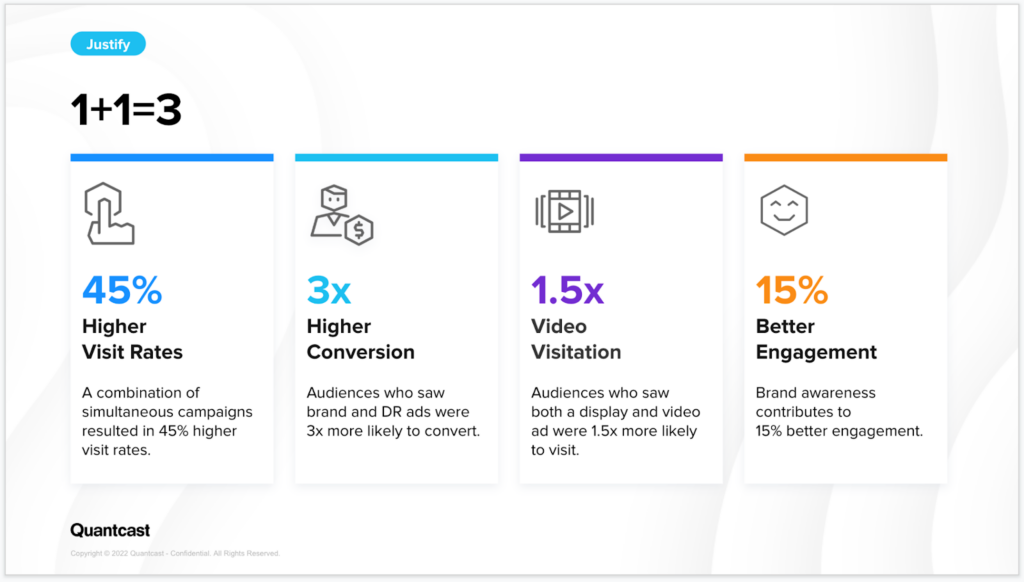Brand marketing budgets are usually the first to get cut during times of economic uncertainty—even though sustained investment in brand translates to improved awareness, performance, and competitive advantage. While many marketers find justifying brand marketing spending to be a challenge, advances in AI and machine learning technology are making it possible for professionals to understand with precision which activity is leading to return on investment (ROI).
In a recent webinar hosted by Adweek, Embrace Brand on Top of Demand: Recession-Proof Your Ad Spend, our CTO, Dr. Peter Day, and Head of Insights, Rohini Sen, took an in-depth look at why embracing brand spend on top of demand is key to remaining relevant and setting your brand up for future success despite challenging times.
Here are some of the webinar’s key takeaways.
Recessions reward brand advertisers
Taking a look at past recessions, we can see proof that brands that invested in their advertising budget, instead of making major cuts, became industry leaders. During the Great Depression in the 1920s, Kellogg’s overtook Post as the top-selling cereal company–and has been the leader ever since–when they doubled their budget to run radio ads. In the midst of the 1970s energy crisis, Toyota was tempted to make cuts but instead honed in on their long-term marketing plans, which helped them surpass Volkswagen, making them the top imported carmaker a year after the recession ended. In the 1990s, when McDonald’s eliminated its marketing budget, Pizza Hut increased sales by 61% and Taco Bell by 40% when they kept promoting their new offerings and value menu; conversely, McDonald’s sales dropped 28%. And in the 2008 financial crisis, Del Monte’s CMO slashed and burned the old way of dealing with a recession, increasing ad spend with a memorable fruit campaign, which took the company from a loss of $10.1 million to a profit of $58.6 million.
Opting-out of a recession
When asked about the recession in 1991, the founder of Walmart, Sam Walton, responded: “I’ve thought about it, but I have chosen not to participate.” While that seems easier said than done, there are ways to do it. Make sure you have the tools you need to protect and defend your budget:
- Jump into the consumer insights that drive more than media. With real-time consumer insights, marketers can respond quickly and optimize their advertising dollars. For example, at the start of the pandemic, a B2B client was able to use Quantcast’s real-time data to understand that the typical consumers for their cloud computing software had dramatically changed. In addition to their usual CTO decision-maker audience, a younger demographic was using the lockdown time to develop their skills, so the company was able to expand their offering to reach (and lockdown) this new generation of consumers.
- Justify your spend by measuring the full funnel. Instead of being laser-focused on any individual metric, brands can succeed by taking a holistic approach. When Auto Trader wanted to increase consideration with new car buyers by introducing an omnichannel brand strategy, they needed to be able to quantify the impact of their new upper funnel video investments on their sales goals. They were able to determine that consumers who were exposed to both upper and lower funnel creatives had an incredible 50% conversion lift (versus only being exposed to lower funnel), proving the value in every media dollar spent. We have consistently found that when you combine brand and demand advertising, executing across the full funnel, you drive more with less.

- Make agile decisions with real-time data. Unlike previous recessions, marketers now have access to real-time data, which is a game-changer. Even for a client that already had double digit favorability lift, Quantcast was able to use real-time data to determine that capping their frequency at three times a week would drive further lift and favorability–and it improved the results of the campaign by 62%. By optimizing the campaign and adjusting frequency based on in-flight learnings, they were able to outperform benchmarks by 3x.
With consumer insights to drive campaign optimization, measurement to justify ad spend across the funnel, and agility to make decisions based on real-time data, marketers can come out of this recession ahead. To learn more about measuring the impact of your brand marketing dollars, the importance of testing and adapting messaging, and why a long-term investment approach is key, you can watch the entire on-demand webinar.
Learn more
For Quantcast CMO Deb Stambaugh’s perspective on this topic, read Recession-Proofing Brand Budgets. And to find out more about unifying brand and performance campaigns for better results, read Redefining Brand Advertising for Modern Marketers and How Top Brands Are Driving Stronger Performance from Brand Spend.
